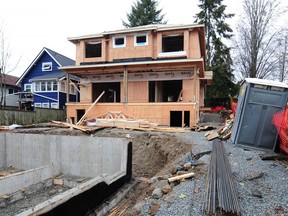B.C. and Ottawa both offering loans to help with the cost of building secondary suites. Here’s what you need to know about both programs.

Homeowners in B.C. who want help covering the cost of converting an unused basement into a rental apartment or a garage into a laneway home can tap provincial or federal loan programs that are part of much larger plans to increase the housing supply.
But each program comes with a lot of fine print.
Here’s a rundown of what you need to know:
What do the programs offer?
Applicants can use the loans toward adding a secondary suite or an accessory dwelling unit such as a garden suite, laneway house or carriage home on the property that is their primary residence.
If the unit is rented long-term at below market rates for at least five years, the loan will be forgiven. The province’s goal is to give these forgivable loans to 1,000 homeowners each year as a way of adding 3,000 new rental units at below-market rates.
The federal program also comes with mortgage insurance changes so homeowners can refinance insured mortgages and access home equity for making renovations or constructing secondary suites.
When and for how long will the programs be available?
The federal program was announced as part of the 2024 budget and will come into effect starting Jan. 15, 2025. It’s a four-year program.
What are the restrictions?
To be eligible for the provincial program, a homeowner has to obtain a building and occupancy permit from their local government. The combined gross annual income of the homeowners on title has to be less than $209,420 and the B.C. Assessment value on their property has to be below the homeowner grant threshold, which was $2.15 million in 2024.
The federal loans are available on 15-year terms at a low interest rate of two per cent.
To qualify for refinancing an insured mortgage and accessing home equity to finance renovations or construction of a secondary suite, a homeowner has to already own the property and intend to live in the secondary suite or have a close relative live in it. The additional unit can’t be used as a short-term rental and it must be fully self-contained. The maximum number of units is four, including the existing one.
The “as-improved” value of the eligible residential property against which the loan is secured must be less than $2 million. The maximum loan-to-value limit is up to 90 per cent of the property value, including the value of the new suites, plus any other outstanding loans. The maximum amortization period is 30 years.
How can they be used?
Homeowners can go to B.C. Assessment’s secondary suite website and do a quick assessment to check if they’re eligible. B.C. Housing is approving applications on a first-come, first-served basis.
Can the provincial and federal loans be used in tandem?
Homeowners in B.C. may receive loans from the federal secondary suite loan in addition to the provincial secondary suite incentive program, as long as the homeowners are eligible for both programs and their primary mortgage lender allows for it, according to the B.C. Housing and Municipal Affairs Ministry.
David Hutniak, CEO at Landlord B.C., which represents owners and managers of rental housing, said the provincial program received considerable upfront interest according to the Housing Ministry, “but it will be some time before we know how many units are actually created.”
A survey of Landlord B.C. members when the program was announced “did not garner the same level of enthusiasm because of the requirement to rent the completed secondary suites at below market rates for five years, said Hutniak.